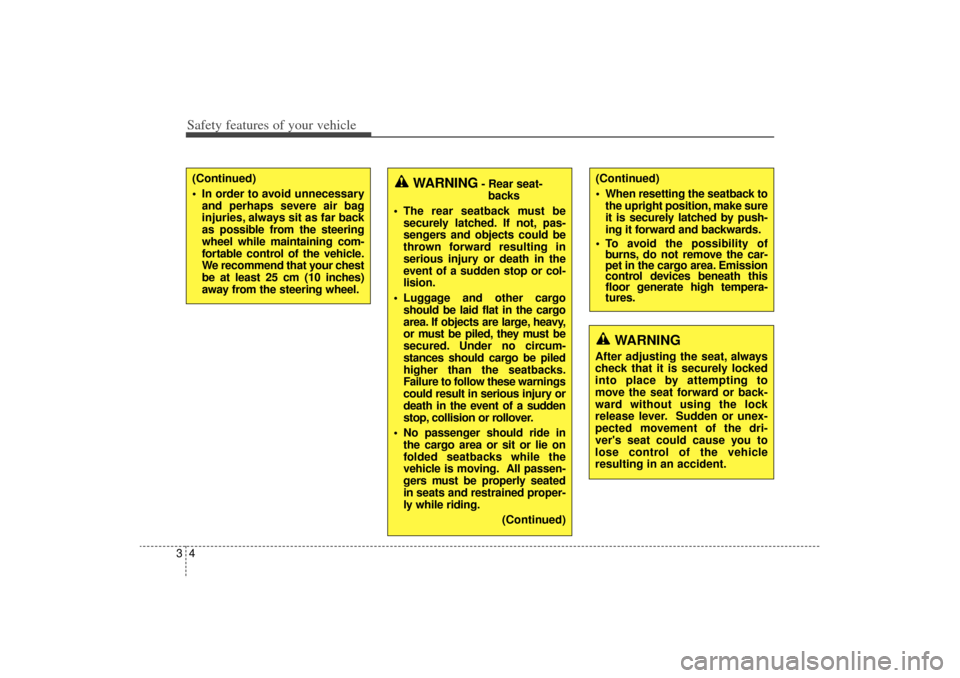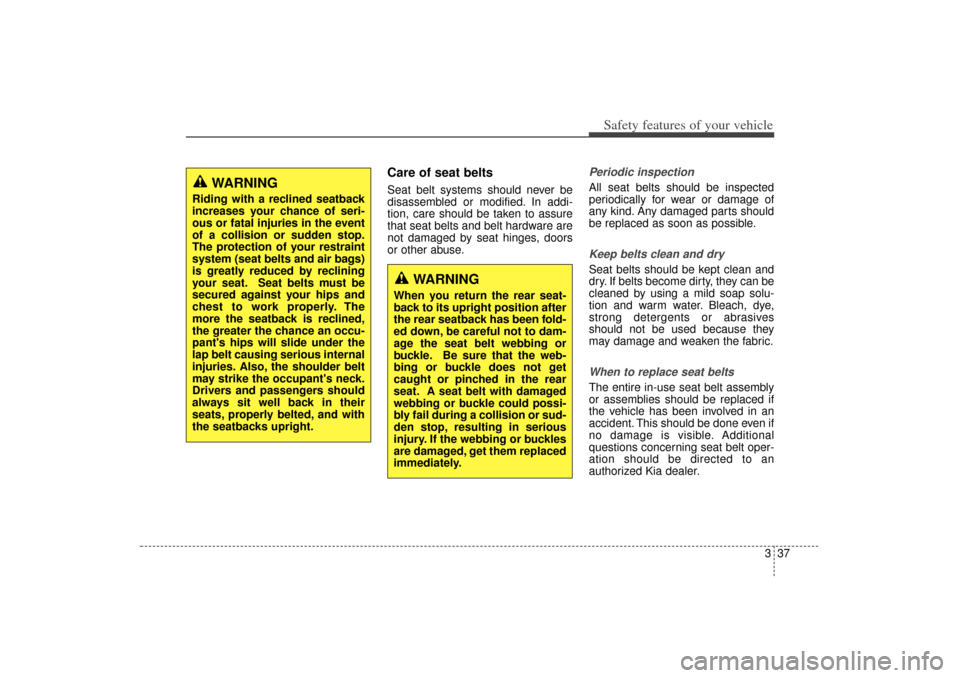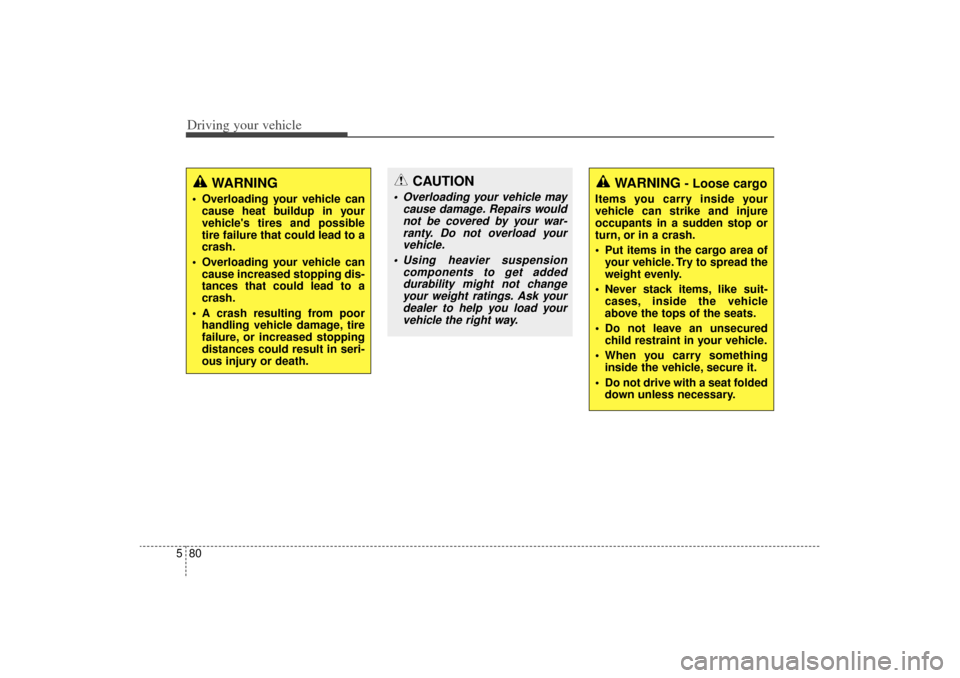2014 KIA Sorento fold seats
[x] Cancel search: fold seatsPage 16 of 508

Safety features of your vehicle23
Front seat(1) Forward and backward
(2) Seatback angle
(3) Seat cushion height (Driver’s seat)
(4) Lumbar support (Driver’s seat)*
(5) Seat warmer* / Seat cooler (Air ventilation seat)*
(6) Headrest2nd row seat(7) Forward and backward*
(8) Seatback angle and folding
(9) Headrest
(10) Armrest
(11) Seat warmer*3rd row seat*(12) Seatback folding
(13) Headrest* if equipped
SEATS
OXMA033001
Manual seat
Manual seat
Power seat
Power seat
XM(FL) CAN(ENG) 3.QXP 1/23/2013 3:22 PM Page 2
Page 18 of 508

Safety features of your vehicle43
(Continued)
When resetting the seatback tothe upright position, make sure
it is securely latched by push-
ing it forward and backwards.
To avoid the possibility of burns, do not remove the car-
pet in the cargo area. Emission
control devices beneath this
floor generate high tempera-
tures.
WARNING
After adjusting the seat, always
check that it is securely locked
into place by attempting to
move the seat forward or back-
ward without using the lock
release lever. Sudden or unex-
pected movement of the dri-
ver's seat could cause you to
lose control of the vehicle
resulting in an accident.
(Continued)
In order to avoid unnecessary
and perhaps severe air bag
injuries, always sit as far back
as possible from the steering
wheel while maintaining com-
fortable control of the vehicle.
We recommend that your chest
be at least 25 cm (10 inches)
away from the steering wheel.
WARNING
- Rear seat-backs
The rear seatback must be securely latched. If not, pas-
sengers and objects could be
thrown forward resulting in
serious injury or death in the
event of a sudden stop or col-
lision.
Luggage and other cargo should be laid flat in the cargo
area. If objects are large, heavy,
or must be piled, they must be
secured. Under no circum-
stances should cargo be piled
higher than the seatbacks.
Failure to follow these warnings
could result in serious injury or
death in the event of a sudden
stop, collision or rollover.
No passenger should ride in the cargo area or sit or lie on
folded seatbacks while the
vehicle is moving. All passen-
gers must be properly seated
in seats and restrained proper-
ly while riding.
(Continued)
XM(FL) CAN(ENG) 3.QXP 1/23/2013 3:22 PM Page 4
Page 33 of 508

319
Safety features of your vehicle
To fold down the rear center seat-back (for 2nd row seat)1. Lower the rear headrests to the lowest position.
2. Push the center seatback folding lever up, then fold the seat toward
the front of the vehicle.
When you return the seatback to its
upright position, always be sure it
has locked into position by pushing
on the top of the seatback.
ODM032033
WARNING
- 2nd row cen-
ter seat folding
Do not fold the 2nd row center seat, if there are occupants in
the 3rd row seats, as this may
result in injury to occupants if
the seat moves during a colli-
sion. If occupants in the 3rd
row seats, fix the 2nd row cen-
ter seat in its upright and
locked position.
The 2nd row center seat back does not lock into position
when it is folded toward the
front of the vehicle. If you use
the 2nd row center seat back
folding function to carry long
objects, you should fix the
long object to prevent it from
being thrown about the vehi-
cle in a collision and causing
injury to vehicle occupants.
WARNING -
Uprighting
seat
When you return the seatback
to its upright position, hold the
seatback and return it slowly. If
the seatback is returned with-
out holding it, the back of the
seat could spring forward
resulting in injury caused by
being struck by the seatback.
CAUTION -
Damaging
rear seat belt buckles
When you fold the rear (2nd and/or 3rd row) seatback, insertthe buckle in the pocket betweenthe rear seatback and cushion.Doing so can prevent the bucklefrom being damaged by the rearseatback.
XM(FL) CAN(ENG) 3.QXP 1/23/2013 3:24 PM Page 19
Page 51 of 508

337
Safety features of your vehicle
Care of seat beltsSeat belt systems should never be
disassembled or modified. In addi-
tion, care should be taken to assure
that seat belts and belt hardware are
not damaged by seat hinges, doors
or other abuse.
Periodic inspectionAll seat belts should be inspected
periodically for wear or damage of
any kind. Any damaged parts should
be replaced as soon as possible.Keep belts clean and drySeat belts should be kept clean and
dry. If belts become dirty, they can be
cleaned by using a mild soap solu-
tion and warm water. Bleach, dye,
strong detergents or abrasives
should not be used because they
may damage and weaken the fabric.When to replace seat beltsThe entire in-use seat belt assembly
or assemblies should be replaced if
the vehicle has been involved in an
accident. This should be done even if
no damage is visible. Additional
questions concerning seat belt oper-
ation should be directed to an
authorized Kia dealer.
WARNING
When you return the rear seat-
back to its upright position after
the rear seatback has been fold-
ed down, be careful not to dam-
age the seat belt webbing or
buckle. Be sure that the web-
bing or buckle does not get
caught or pinched in the rear
seat. A seat belt with damaged
webbing or buckle could possi-
bly fail during a collision or sud-
den stop, resulting in serious
injury. If the webbing or buckles
are damaged, get them replaced
immediately.
WARNING
Riding with a reclined seatback
increases your chance of seri-
ous or fatal injuries in the event
of a collision or sudden stop.
The protection of your restraint
system (seat belts and air bags)
is greatly reduced by reclining
your seat. Seat belts must be
secured against your hips and
chest to work properly. The
more the seatback is reclined,
the greater the chance an occu-
pant's hips will slide under the
lap belt causing serious internal
injuries. Also, the shoulder belt
may strike the occupant's neck.
Drivers and passengers should
always sit well back in their
seats, properly belted, and with
the seatbacks upright.
XM(FL) CAN(ENG) 3.QXP 1/23/2013 3:25 PM Page 37
Page 89 of 508

375
Safety features of your vehicle
Additional safety precautions
Never let passengers ride in the
cargo area or on top of a folded-
down back seat. All occupants
should sit upright, fully back in their
seats with their seat belts on and
their feet on the floor.
Passengers should not move
out of or change seats while the
vehicle is moving. A passenger
who is not wearing a seat belt dur-
ing a crash or emergency stop can
be thrown against the inside of the
vehicle, against other occupants,
or out of the vehicle.
Each seat belt is designed to
restrain one occupant. If more
than one person uses the same
seat belt, they could be seriously
injured or killed in a collision.
Do not use any accessories on
seat belts. Devices claiming to
improve occupant comfort or repo-
sition the seat belt can reduce the
protection provided by the seat belt
and increase the chance of serious
injury in a crash.
Passengers should not place
hard or sharp objects between
themselves and the air bags.
Carrying hard or sharp objects on
your lap or in your mouth can result
in injuries if an air bag inflates.
Keep occupants away from the
air bag covers. All occupants
should sit upright, fully back in their
seats with their seat belts on and
their feet on the floor. If occupants
are too close to the air bag covers,
they could be injured if the air bags
inflate.
Do not attach or place objects
on or near the air bag covers.
Any object attached to or placed
on the front or side air bag covers
could interfere with the proper
operation of the air bags.
Do not modify the front seats.
Modification of the front seats
could interfere with the operation of
the supplemental restraint system
sensing components or side air
bags.
(Continued)
If the air bags inflate, they
must be replaced by an
authorized Kia dealer.
Do not tamper with or discon- nect SRS wiring, or other
components of the SRS sys-
tem. Doing so could result in
injury, due to accidental infla-
tion of the air bags or by ren-
dering the SRS inoperative.
If components of the air bag system must be discarded, or
if the vehicle must be
scrapped, certain safety pre-
cautions must be observed.
An authorized Kia dealer
knows these precautions and
can give you the necessary
information. Failure to follow
these precautions and proce-
dures could increase the risk
of personal injury.
If your vehicle was flooded and has soaked carpeting or
water on flooring, you should-
n't try to start the engine;
have the vehicle towed to an
authorized Kia dealer.
XM(FL) CAN(ENG) 3.QXP 1/23/2013 3:26 PM Page 75
Page 385 of 508

Driving your vehicle80
5
WARNING
Overloading your vehicle can
cause heat buildup in your
vehicle's tires and possible
tire failure that could lead to a
crash.
Overloading your vehicle can cause increased stopping dis-
tances that could lead to a
crash.
A crash resulting from poor handling vehicle damage, tire
failure, or increased stopping
distances could result in seri-
ous injury or death.
WARNING
- Loose cargo
Items you carry inside your
vehicle can strike and injure
occupants in a sudden stop or
turn, or in a crash.
Put items in the cargo area ofyour vehicle. Try to spread the
weight evenly.
Never stack items, like suit- cases, inside the vehicle
above the tops of the seats.
Do not leave an unsecured child restraint in your vehicle.
When you carry something inside the vehicle, secure it.
Do not drive with a seat folded down unless necessary.
CAUTION
Overloading your vehicle may cause damage. Repairs wouldnot be covered by your war-ranty. Do not overload yourvehicle.
Using heavier suspension components to get addeddurability might not changeyour weight ratings. Ask yourdealer to help you load yourvehicle the right way.
XM(FL) CAN(ENG) 5.QXP 1/23/2013 3:32 PM Page 80